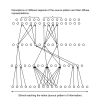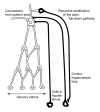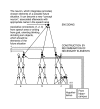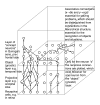A current model of neural circuitry active in forming mental images
- PMID: 24335907
- PMCID: PMC3867620
- DOI: 10.12659/MSM.889587
A current model of neural circuitry active in forming mental images
Abstract
My aim here is to formulate a compact, intuitively understandable model of neural circuits active in imagination that would be consistent with the current state of knowledge, but that would be simple enough to be able to use for teaching. I argue that such a model should be based on the recent idea of "concept neurons" and circuits of 2 separate loops necessary for recalling mental images and consolidation of memory traces of long-term memory. This paper discusses the role of the hippocampus and temporal lobe, emphasizing the essential importance of recurrent pathways and oscillations occurring in the upper layers of hierarchical neural structures, as well as oscillations in thalamo-cortical loops. The elaborated model helps explain specific processes such as imagining future situations, novel objects, and anticipated action, as well as imagination concerning oneself, which is indispensable for the sense of identity and self-awareness. I attempt to present this compact, simple model of neural circuitry active in imagination by using some intuitive, demonstrative figures.
Figures









Similar articles
-
On the nature of medial temporal lobe contributions to the constructive simulation of future events.Philos Trans R Soc Lond B Biol Sci. 2009 May 12;364(1521):1245-53. doi: 10.1098/rstb.2008.0308. Philos Trans R Soc Lond B Biol Sci. 2009. PMID: 19528005 Free PMC article. Review.
-
The ensemble that plays together, stays together.Hippocampus. 2004;14(1):1-3. doi: 10.1002/hipo.20004. Hippocampus. 2004. PMID: 15058475 Review. No abstract available.
-
Neuroscience: friends and grandmothers.Nature. 2005 Jun 23;435(7045):1036-7. doi: 10.1038/4351036a. Nature. 2005. PMID: 15973389 No abstract available.
-
The Sync/deSync Model: How a Synchronized Hippocampus and a Desynchronized Neocortex Code Memories.J Neurosci. 2018 Apr 4;38(14):3428-3440. doi: 10.1523/JNEUROSCI.2561-17.2018. Epub 2018 Feb 27. J Neurosci. 2018. PMID: 29487122 Free PMC article.
-
When shared concept cells support associations: Theory of overlapping memory engrams.PLoS Comput Biol. 2021 Dec 30;17(12):e1009691. doi: 10.1371/journal.pcbi.1009691. eCollection 2021 Dec. PLoS Comput Biol. 2021. PMID: 34968383 Free PMC article.
Cited by
-
Larger Volume and Different Activation of the Brain in Response to Threat in Military Officers.Basic Clin Neurosci. 2020 Sep-Oct;11(5):669-685. doi: 10.32598/bcn.9.10.160. Epub 2020 Sep 1. Basic Clin Neurosci. 2020. PMID: 33643560 Free PMC article.
-
Neural Circuits, Microtubule Processing, Brain's Electromagnetic Field-Components of Self-Awareness.Brain Sci. 2021 Jul 25;11(8):984. doi: 10.3390/brainsci11080984. Brain Sci. 2021. PMID: 34439603 Free PMC article. Review.
-
Effects of duloxetine on microRNA expression profile in frontal lobe and hippocampus in a mouse model of depression.Int J Clin Exp Pathol. 2015 Nov 1;8(11):15454-61. eCollection 2015. Int J Clin Exp Pathol. 2015. PMID: 26823914 Free PMC article.
References
-
- Brodziak A. Neurophysiology of the mental image. Med Sci Monit. 2001;7(3):534–38. - PubMed
-
- Mishkin MH. A memory system in the monkey. Philos Trans R Soc Lond B Biol Sci. 1982;298:83–95. - PubMed
-
- Quiroga RQ. Concept cells: the building blocks of declarative memory functions. Nat Rev Neurosci. 2012;13:587–97. - PubMed
-
- Reddy L, Quiroga RQ, Wilken P, et al. A single-neuron correlate of change detection and change blindness in the human medial temporal lobe. Curr Biol. 2006;16:2066–72. - PubMed
-
- Kraskov A, Quiroga RQ, Reddy L, et al. Local field potentials and spikes in the human medial temporal lobe are selective to image category. J Cogn Neurosci. 2007;19:479–92. - PubMed
MeSH terms
LinkOut - more resources
Full Text Sources
Other Literature Sources
Medical

